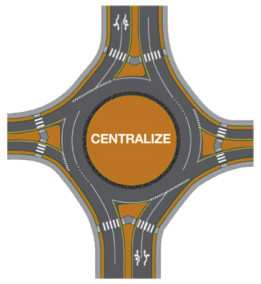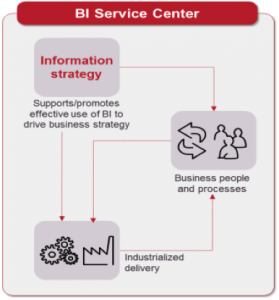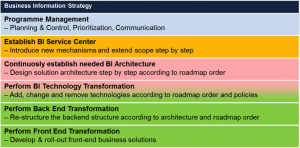An IT strategist and Enterprise Architects reflection..
PART 2 – The Gold Mine
Previously on SogetiLabs
In yesterday’s article we took off from the swamp by re-thinking and implementing a new mindset of information management.
Here is the continuation..
Re-organize
 As a result of the new implemented mindset, it is natural to re-organize the information management organisation.
As a result of the new implemented mindset, it is natural to re-organize the information management organisation.
Bring all different organizations working in the area of information management together in to one. Logically it can be seen as centralization, but the important thing is to bring together the competence and technologies.
To just bring people together will make quite a lot of sense in reducing complexity and increasing efficiency.
Integrations will be more harmonized and reused. Master data will probably be taken care of with an enterprise perspective for the first time. A common architecture for Business Intelligence may also come out as a result.
Establish a service center
 The most important success factor and main driver for the transformation and re-organization of Business Intelligence into well-structured and efficient Business Information Management is a center for information based developments, the Business Information Service Center (BISC).
The most important success factor and main driver for the transformation and re-organization of Business Intelligence into well-structured and efficient Business Information Management is a center for information based developments, the Business Information Service Center (BISC).
Forrester research puts the BISC first on the BI transformation check list together with CxO buy-in.
A BISC is on a high level a mechanism, a factory, where processes, people, governance, aspects and competence are brought together into a functioning whole.
It is not important to bring everything on the table from the beginning.
Start simple and evolve step-by-step. The most important initially is to:
- establish basic processes
- establish the most important governance mechanisms
- secure that developments are channeled through the service center
- pick the most important information management development areas
- establish lean based procedures for continuous improvements and quality assurance
- define/produce the architecture needed to achieve delivery quality, process efficiency and strategic alignment in the service center
- transform the business and IT strategies into a useful BI strategy framework
Define concrete and valuable architecture
Architecture in the traditional BI area is often quite weak. If there is an architecture in place, it is mostly on an infrastructure level, telling what physical products should be used. It is also common to design and decide about a design pattern for the datawarehouse data models. As an architect I must say that most of the architecture needed in other IT solution areas is missing.
How shall the standard technology be used? What are the logical solution patterns? How do we secure the enterprise level? How shall it fit in the total picture? BI never lives alone!
Logical solution patterns have to be defined based on the business demand, and then populated with physical components/products. Architecture work as usual!
To be more sharp and precise, identify and design the architecture needed in the BI Service Center processes. Then you will always be safe. Don’t get stuck with the traditional definitions of Information Architecture, which is more related to Content Management only. The architecture needed is far more than that.
Produce a useful BI strategy
Strategy is not complicated, and I say that as a strategist. I have done different type of strategies, but when entering the area of traditional BI, strategy seems to be something else. In some cases the BI strategy is just about defining the KPIs for the business strategy (??). Well, I can admit that it is valuable and fruitsome exercise, but it still just leads to a little bit further developed business strategy, not a BI strategy.
The areas of strategy I would like to see in a BI strategy are:
- BI alignment with business strategies, how BI shall support the strategies?
- Incl. Technovision, what new BI technologies can enable the business strategies
- Technology roadmaps, when to introduce what technologies?
- Scoping, what logical BI application areas/patterns will be needed?
- Action areas based on current problems, opportunities and business strategy
- High-level business case
- Model for a transformation programme
- Important viewpoints are delivery processes, governance procedures and rules, sourcing, Architecture, Back-end structure, Front-end structure
There are many good prescriptions on the Internet on how to build a BI strategy and BI transformation plan. Pick the best practices and build what structure is best for you
Transformation Programme
In order to safely reach the desired destination, it is important to build patience and endurance. It is also important to create a transformation structure that makes sense. Here’s my last bid on that. The different areas are transformation streams.
The Front End part is the one close to the business, the one that should drive the transformation programme. To Establish the BI Service Center is a pre-requisite for the transformation performing streams. Technology transformations may also be driven from IT policies, for example that certain technologies shall be phased-out latest at a specific date. An initial high-level architecture is a pre-requisite for the programme itself. Within the programme architecture is continuously detailed depending on sub project scope and specific needs.
Make BI a goldmine!
Goldmine may not be the best metaphor. “Treasury” is a better term. In a discussion with a Director of strategy in a large company, he stated; “we have so much data in our systems, our problem is that we are not using it smart to sharpen our business”. I think that’s a case for many organizations.
Some of you out there already are successful, but for the rest I say; don’t wait, start to plan your transformation tomorrow. Every day you wait will make the transformation harder.
Define your BI Strategy, put together your own BI Service Center and armour it with the right processes, architecture, governance, competence and people. Then just let it roll. It will take some time, so work hard to maintain direction and patience.

 English | EN
English | EN 


